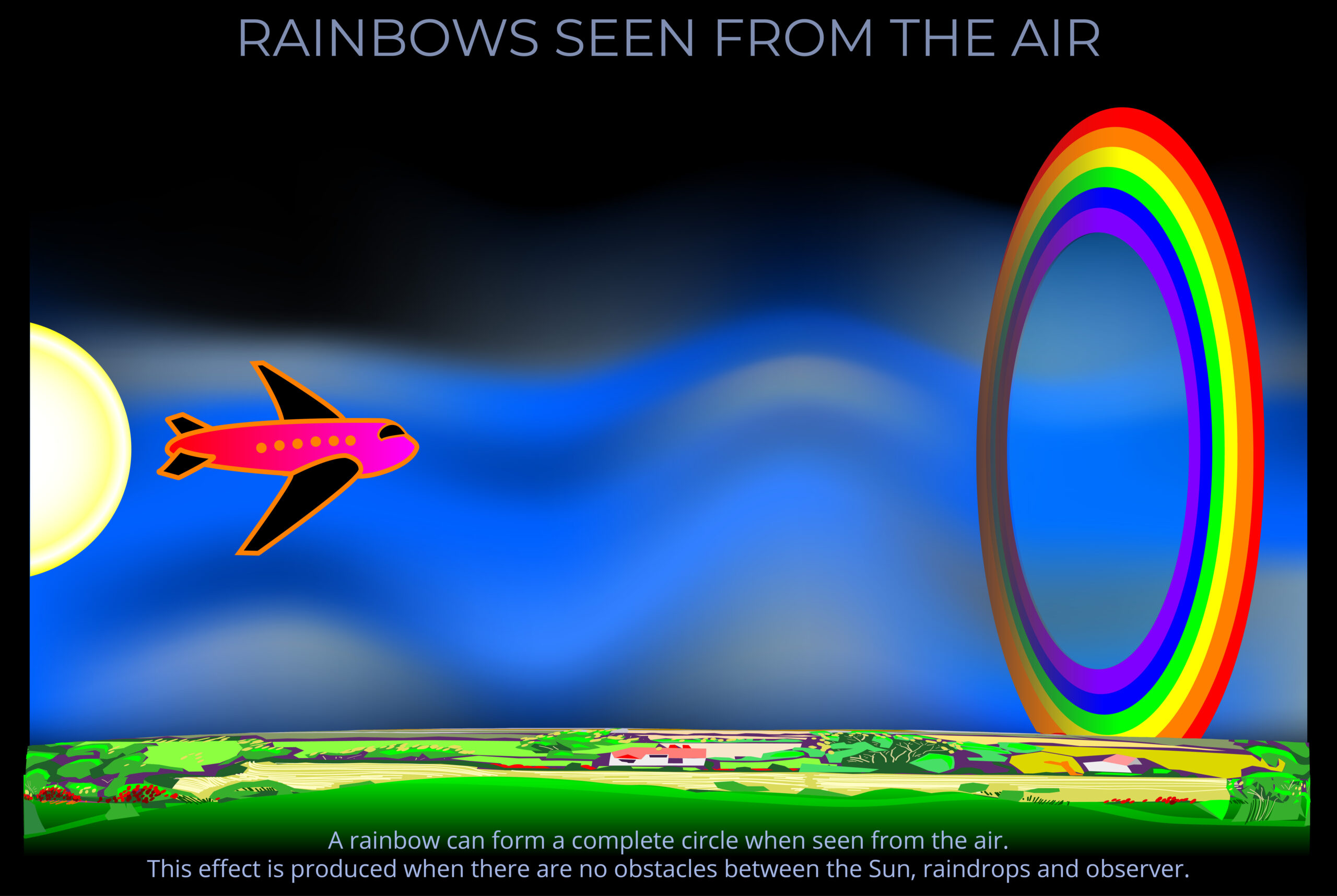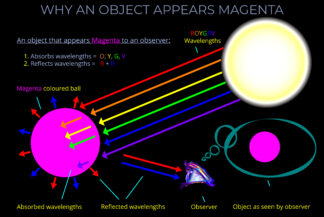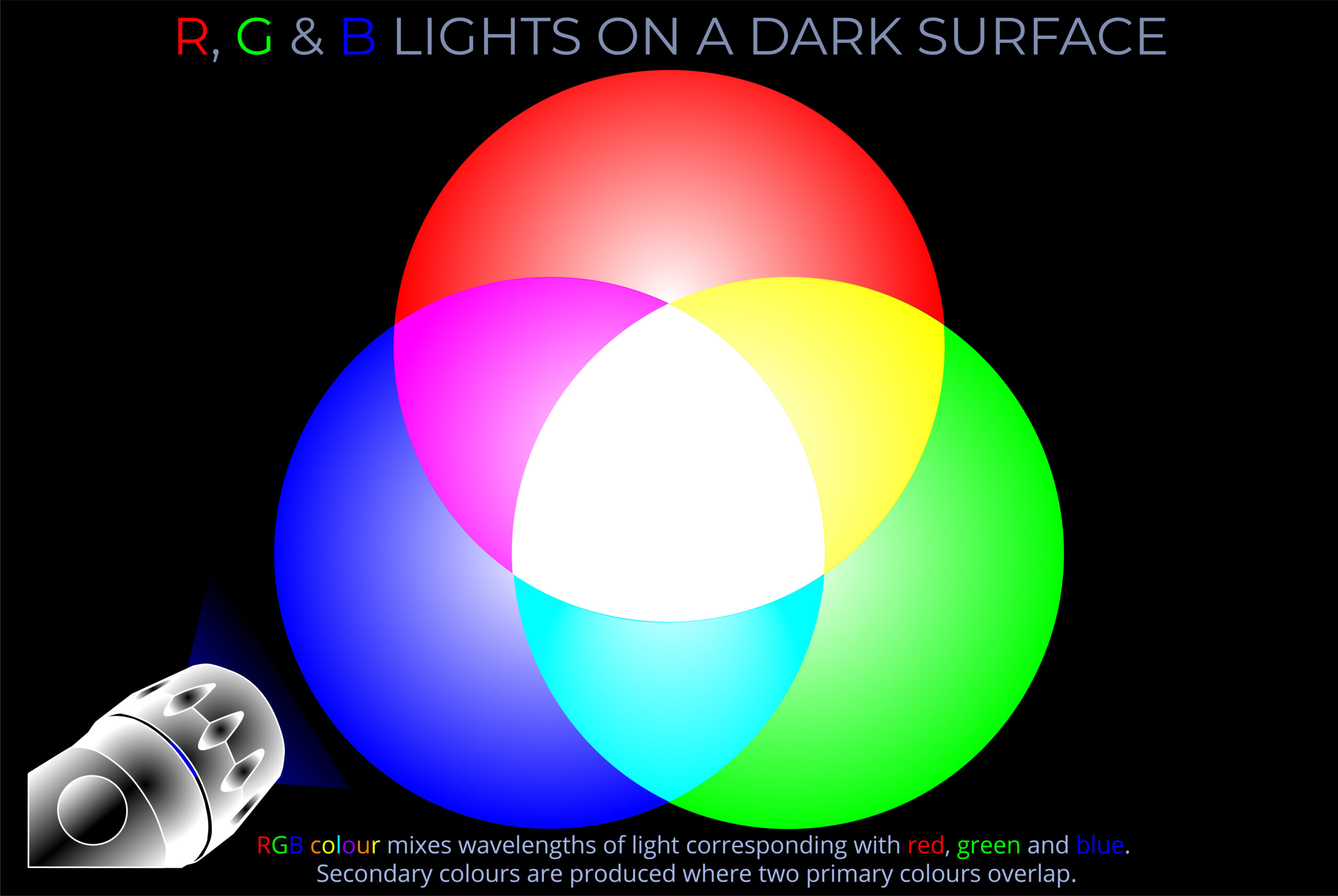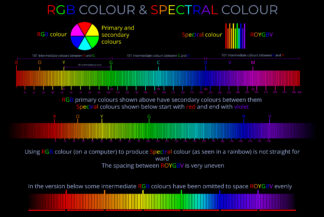Rainbows Seen From the Air
£0.00
This is one of a set of almost 40 diagrams exploring Rainbows.
Each diagram appears on a separate page and is supported by a full explanation.
- Follow the links embedded in the text for definitions of all the key terms.
- For quick reference don’t miss the summaries of key terms further down each page.
Description
Rainbows Seen From the Air
TRY SOME QUICK QUESTIONS AND ANSWERS TO GET STARTED
About the Diagram
An overview of rainbows
About the diagram: Atmospheric rainbow summary
Visual processing
Visual processing is a complex and dynamic process that involves interactions between various retinal cells, neural pathways, and brain regions, ultimately leading to conscious visual perception.
Visual processing begins the moment light enters the human eye. It then progresses through multiple stages as signals travel towards the visual cortex, where the neural activity is integrated, resulting in conscious visual experience.
As visual processing begins the retina starts to process information about colors, as well as basic information about the shape and movement associated with those colors. By the end of this stage, multiple forms of information about a visual scene are ready to be conveyed to higher brain regions.
Let’s examine two major forms of processing, trichromatic and opponent-processing, which occur within the eyeball as visual information is gathered from light entering our eyes.
Trichromacy, also known as the trichromatic theory of colour vision, explains how three types of cone receptors in the retina work together with bipolar cells to perform their role in the initial stage of colour processing. Rod cells also play a significant role in this form of processing visual information, particularly in low-light conditions.
Opponent-processing, also known as the opponent-process theory of colour vision, explains the second form of processing. Opponent-processing involves ganglion cells that process the data received from trichromatic processing and combine it with other intercellular activities.
It is interesting to note that as both trichromatic and opponent-process theories developed over the last century, researchers and authors have often pitted one theory against the other. However, both processes are crucial for understanding how colour vision occurs.
Trichromatic theory explains the encoding of visual information when light hits the retina, while opponent-processing explains a subsequent stage of information convergence, assembly, and coding before the data leaves the retina via the optic nerve.
Note that:
- Both trichromatic and opponent-processing occur independently within each retina, without comparing with the other.
- Each eye gathers information from a specific viewpoint, approximately 50 mm to the left or right of the nose.
- The two impressions are later compared and combined to provide us with a single three-dimensional, stereoscopic view of the world, rather than two flattened images.
We can consider the layers of retinal cells involved in trichromatic and opponent-processing as examining, interpreting, and transmitting visually relevant information. However, it would be incorrect to view this as a straightforward linear process due to the intricate neural networking, cross-referencing, and feedback loops within the retina.
Some Key Terms
A human observer is a person who engages in observation by watching things.
- In the presence of visible light, an observer perceives colour because the retina at the back of the human eye is sensitive to wavelengths of light that fall within the visible part of the electromagnetic spectrum.
- The visual experience of colour is associated with words such as red, blue, yellow, etc.
- The retina’s response to visible light can be described in terms of wavelength, frequency and brightness.
- Other properties of the world around us must be inferred from light patterns.
- An observation can take many forms such as:
- Watching an ocean sunset or the sky at night.
- Studying a baby’s face.
- Exploring something that can’t be seen by collecting data from an instrument or machine.
- Experimenting in a laboratory setting.
- The observer effect is a principle of physics and states that any interaction between a particle and a measuring device will inevitably change the state of the particle. This is because the act of measurement itself imposes a disturbance on the particle’s wave function, which is the mathematical description of its state.
- The concept of observation refers to the act of engaging with an electron or other particle, achieved through measuring its position or momentum.
- In the context of quantum mechanics, observation isn’t a passive undertaking, observation actively alters a particle’s state.
- This means that any kind of interaction with an atom, or with one of its constituent particles, that provides insight into its state results in a change to that state. The act of observation is always intrusive and will always change the state of the object being observed.
- It can be challenging to reconcile this with our daily experience, where we believe we can observe things without inducing any change in them.
Visible light is the range of wavelengths of electromagnetic radiation perceived as colour by human observers.
- Visible light is a form of electromagnetic radiation.
- Other forms of electromagnetic radiation include radio waves, microwaves, infrared, ultraviolet, X-rays, and gamma rays.
- Visible light is perceived by a human observer as all the spectral colours between red and violet plus all other colours that result from combining wavelengths together in different proportions.
- A spectral colour is produced by a single wavelength of light.
- The complete range of colours that can be perceived by a human observer is called the visible spectrum.
- The range of wavelengths that produce visible light is a very small part of the electromagnetic spectrum.
The visible part of the electromagnetic spectrum is called the visible spectrum.
- The visible spectrum is the range of wavelengths of the electromagnetic spectrum that correspond with all the different colours we see in the world.
- As light travels through the air it is invisible to our eyes.
- Human beings don’t see wavelengths of light, but they do see the spectral colours that correspond with each wavelength and colours produced when different wavelengths are combined.
- The visible spectrum includes all the spectral colours between red and violet and each is produced by a single wavelength.
- The visible spectrum is often divided into named colours, though any division of this kind is somewhat arbitrary.
- Traditional colours referred to in English include red, orange, yellow, green, blue, and violet.
Sunlight, also known as daylight or visible light, refers to the portion of electromagnetic radiation emitted by the Sun that is detectable by the human eye. It is one form of the broad range of electromagnetic radiation produced by the Sun. Our eyes are particularly sensitive to this specific range of wavelengths, enabling us to perceive the Sun and the world around us.
- Sunlight is only one form of electromagnetic radiation emitted by the Sun.
- Sunlight is only a very small part of the electromagnetic spectrum.
- Sunlight is the form of electromagnetic radiation that our eyes are sensitive to.
- Other types of electromagnetic radiation that we are sensitive to, but cannot see, are infrared radiation that we feel as heat and ultraviolet radiation that causes sunburn.
Rainbow colours are the colours seen in rainbows and in other situations where visible light separates into its different wavelengths and the spectral colours corresponding with each wavelength become visible to the human eye.
- The rainbow colours (ROYGBV) in order of wavelength are red (longest wavelength), orange, yellow, green, blue and violet (shortest wavelength).
- It is the sensitivity of the human eye to this small part of the electromagnetic spectrum that results in our perception of colour.
- The names of rainbow colours are a matter more closely related to the relationship between perception and language than anything to do with physics or scientific accuracy. While the spectrum of light and the colours we see are both determined by wavelength, it’s our eyes and brains that turn these differences in light into the colours we experience.
- In the past, rainbows were sometimes portrayed as having seven colours: red, orange, yellow, green, blue, indigo and violet.
- Modern portrayals of rainbows reduce the number of colours to six spectral colours, ROYGBV.
- In reality, the colours of a rainbow form a continuous spectrum and there are no clear boundaries between one colour and the next.
The visible spectrum is the range of wavelengths of the electromagnetic spectrum that correspond with all the different colours we see in the world.
- As light travels through the air it is invisible to our eyes.
- Human beings don’t see wavelengths of light, but they do see the spectral colours that correspond with each wavelength and colours produced when different wavelengths are combined.
- The visible spectrum includes all the spectral colours between red and violet and each is produced by a single wavelength.
- The visible spectrum is often divided into named colours, though any division of this kind is somewhat arbitrary.
- Traditional colours referred to in English include red, orange, yellow, green, blue, and violet.
Visible light refers to the range of wavelengths of electromagnetic radiation that is perceived as colour by human observers. While the range of visible light is generally considered to be 400-700 nm, the exact range of colours perceptible can vary slightly between individuals.
- Visible light is one form of electromagnetic radiation. Other forms of electromagnetic radiation include radio waves, microwaves, infrared, ultraviolet, X-rays, and gamma rays. Visible light ranges from approximately 400 nanometres (nm) for violet to 700 nm for red.
- A human observer perceives visible light as a combination of all the spectral colours between red and violet, as well as a vast range of other colours produced from the blending of different wavelengths in varying proportions.
A rainbow is an optical effect produced by illuminated droplets of water. Rainbows are caused by reflection, refraction (bending) and dispersion (spreading out) of light in individual droplets and result in the appearance of an arc of spectral colours.
- Atmospheric rainbows only appear when weather conditions are ideal and an observer is in the right place at the right time.
- Waterfalls, lawn sprinklers and other things that produce air-borne water droplets can produce a rainbow.
- An atmospheric rainbow is formed from countless individual droplets each of which reflects and refracts a tiny coloured image of the Sun towards the observer.
- As white light passes through water droplets, refraction causes the light to disperse and separate into the different colours seen by an observer.
- If the sun is behind an observer then the rainbow will appear in front of them.
- When a rainbow is produced by sunlight, the angles between the sun, each droplet and the observer determine which ones will form part of the rainbow, the colour each droplet will produce and the sequence in which they appear.



